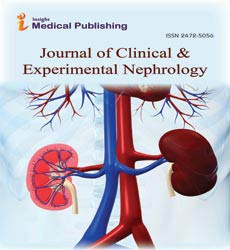Abstract
Serum Soluble (Pro) Renin Receptor Level is Increased in Association with Impaired Renal Function in Patients with Autosomal Dominant Polycystic Kidney Disease
Background: The aim of this study was to examine the relationship between the serum soluble prorenin receptor [(P)RR] levels and various clinical parameters of autosomal dominant polycystic kidney disease (ADPKD) patients.
Methods: A total of 79 patients with ADPKD were enrolled and their serum soluble (P)RR levels were measured with ELISA kits. Serum creatinine (Cr), urea nitrogen (UN), uric acid (UA), and albumin levels, blood haemoglobin (Hb) concentration, plasma renin activity (PRA), plasma aldosterone concentration (PAC), and urinary protein/Cr ratio were also measured.
Results: Univariate analyses showed positive correlations between soluble (P)RR levels and age (P=0.02, r=0.27), serum Cr (P<0.0001, r=0.50), UN (P<0.0001, r=0.45), UA (P=0.04, r=0.23) levels and urinary protein/Cr ratio (P<0.001, r=0.42), negative correlations with estimated glomerular infiltration rate (eGFR) (P<0.0001, r=-0.49) and Hb concentrations (P=0.02, r=-0.26), and no correlation with PRA or PAC levels. Soluble (P)RR levels were positively correlated with total kidney volume (TKV, P<0.01, r=0.35). There was no correlation between soluble (P)RR levels and prescription of renin-angiotensin system inhibitors. Finally, multiple regression analyses showed that serum soluble (P)RR concentration was significantly associated with eGFR after correction TKV.
Conclusions: The serum soluble (P)RR levels correlated with their kidney function of the ADPKD patients, suggesting that soluble (P)RR may be involved in kidney injury and promote the progression of renal dysfunction of ADPKD patients.
Author(s):
Tokiko Miyaoka, Satoshi Morimoto, Hiroshi Kataoka, Toshio Mochizuki, Ken Tsuchiya, Atsuhiro Ichihara and Kosaku Nitta
Abstract | Full-Text | PDF
Share this

Google scholar citation report
Citations : 387
Journal of Clinical & Experimental Nephrology received 387 citations as per google scholar report
Abstracted/Indexed in
- Google Scholar
- Sherpa Romeo
- China National Knowledge Infrastructure (CNKI)
- Directory of Research Journal Indexing (DRJI)
- WorldCat
- Publons
- Secret Search Engine Labs
Open Access Journals
- Aquaculture & Veterinary Science
- Chemistry & Chemical Sciences
- Clinical Sciences
- Engineering
- General Science
- Genetics & Molecular Biology
- Health Care & Nursing
- Immunology & Microbiology
- Materials Science
- Mathematics & Physics
- Medical Sciences
- Neurology & Psychiatry
- Oncology & Cancer Science
- Pharmaceutical Sciences

